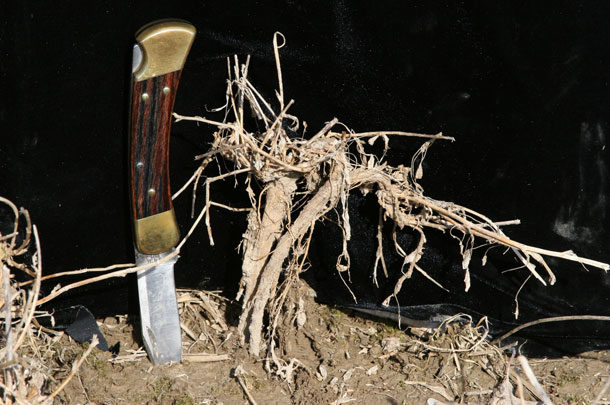Alfalfa will die when the crown area (1 to 3 inches below the soil surface) falls below 13ºF. Grasses will also die with cold root or crown temperatures that vary depending on the grass species. The lack of snow, coupled with cold temperatures (causing the soil temperatures in the crown area of alfalfa and some grasses to fall low enough), resulted in significant winterkill of alfalfa fields across eastern North and South Dakota and central Minnesota. The estimate is that 500,000 acres were affected.
The cold also caused winterkill in some fields across central Wisconsin, particularly in the eastern portion of the state. Additionally, on the heavy soils across central Wisconsin, the mid- to high-40 temperatures with freezing nights during April caused much heaving, which pushed alfalfa crowns out of the soil.
Many plants were pushed 2 to 4 inches out of the ground. In this case, the taproot has broken and haymaking is difficult. Many fields were simply turned over, and other crops were planted. Some farmers left the stands and will take first cutting before turning fields over. Between the cold temperatures and heaving, an estimated 400,000 acres were affected in Wisconsin.
Some stands were injured over the winter in northeastern Iowa, northern Illinois and southern Wisconsin. However, less than 10 percent of the stands were affected, and most suffered thinning rather than large killed areas. Some winterkill was also reported in northern Ohio. Many of these fields were older stands and often stressed due to low soil pH, low soil potassium or sulfur, or cuttings at times that created stress.
Many of the affected fields will be turned over due to low yield from poor stands. Some farmers have asked about interseeding grasses to improve yield from damaged fields. Unfortunately, our research has shown that the yield increase from interseeding grasses into thin alfalfa stands is minimal.
Cool-season perennial grasses like orchardgrass, tall fescue and bromegrass are slow to establish and contribute little until late in the season. Ryegrass (either annual or perennial) will establish much faster. In all cases, grass from interseeding establishes but replaces some alfalfa yield rather than adding to it. Thus, thin alfalfa fields interseeded with grass yield no more than if the grass had not been interseeded.
Lastly, some alfalfa fields suffered injury but were not killed. Alfalfa forms buds in the fall for spring growth. If some of these buds are killed, the plant must start over by making new buds in the spring. Thus, a few buds survived and started to grow, while other buds were formed and came on later.
This is evident in fields where a few stems come out early and other stems (from spring formed buds) are 3 to 4 inches shorter. This uneven height is an indication of yield loss. The yield loss is only relevant to first cutting, and the stand will recover and survive fine. Farmers should note where this occurred and determine if this uneven stem height is related to variety, soil fertility or management, and make changes to reduce future yield losses from winter injury. FG
PHOTO
In some severe winter areas, alfalfa roots heaved 2 to 4 inches. Photo provided by Dan Undersander.

Dan Undersander
Forage Agronomist
University of Wisconsin












